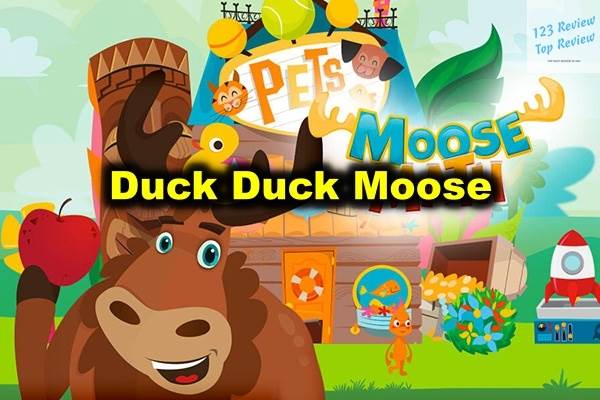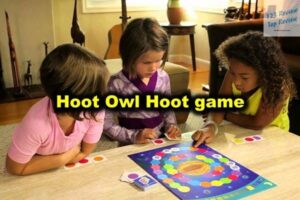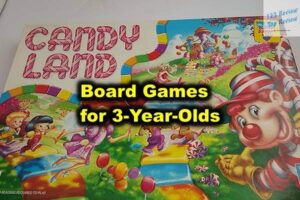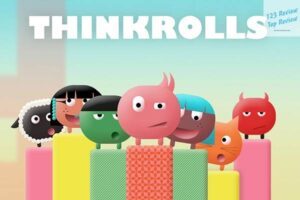In this article, 123 Review explores the various games developed by Duck Duck Moose, which cover a wide range of subjects including math, reading, music, and creative arts. With colorful graphics, engaging animations, and interactive activities, these apps are designed to promote early childhood development by encouraging critical thinking, creativity, and problem-solving skills in a fun and playful environment. Perfect for toddlers and preschoolers, Duck Duck Moose Games provide an entertaining way for kids to learn and grow.
Overview of Duck Duck Moose Games
History and Background of Duck Duck Moose
Duck Duck Moose is a pioneer in the field of educational technology, specifically focusing on creating engaging, interactive apps for early childhood education. The company was founded in 2008 by a trio of innovators: Caroline Hu Flexer, an education technology expert; Michael Flexer, a software engineer; and Nicole Surget, a designer. As parents themselves, they recognized the potential of mobile technology to enhance learning for young children and set out to create products that would combine education with entertainment. From the beginning, Duck Duck Moose has been driven by the belief that learning should be an enjoyable and enriching experience for children. This philosophy has guided the development of all their apps, which are now used by millions of families around the world.

Duck Duck Moose quickly gained recognition for its high-quality educational content. The company’s first app, “Wheels on the Bus,” was an immediate success, introducing a new standard for interactive learning apps. Over the years, Duck Duck Moose expanded its portfolio to include more than 20 apps, each designed to address different aspects of early childhood education, including literacy, numeracy, creativity, and social-emotional learning. These apps have earned numerous awards, including multiple Parents’ Choice Awards and accolades from Children’s Technology Review, solidifying Duck Duck Moose’s reputation as a leader in educational apps for children.
Development and Partnership with Khan Academy
In 2016, Duck Duck Moose entered a transformative partnership with Khan Academy, a globally recognized nonprofit organization dedicated to providing free, world-class education for anyone, anywhere. This strategic alliance marked a significant milestone for Duck Duck Moose, allowing the company to scale its impact while maintaining its core mission of making learning accessible and enjoyable for all children.
The decision to join forces with Khan Academy was driven by a shared commitment to educational equity. By integrating with Khan Academy, Duck Duck Moose was able to offer its entire suite of apps for free, removing financial barriers for families and schools. This move democratized access to high-quality educational tools, ensuring that children from diverse backgrounds could benefit from the innovative learning experiences that Duck Duck Moose provides.
The partnership also brought together the educational expertise of Khan Academy and the creative strengths of Duck Duck Moose. This collaboration has resulted in apps that are not only fun and engaging but also pedagogically sound and aligned with educational standards. By leveraging Khan Academy’s deep understanding of educational content and assessment, Duck Duck Moose has been able to enhance the effectiveness of its apps, ensuring that they support meaningful learning outcomes for young children.
Features of Duck Duck Moose Games
Key Educational Components
Duck Duck Moose games are meticulously designed to support early childhood development by focusing on foundational skills that are essential for success in school and beyond. Each app is developed with input from educators, child development experts, and designers to ensure that the content is both educationally rigorous and developmentally appropriate.
The educational content in Duck Duck Moose games covers a broad range of subjects, including literacy, mathematics, science, and creative arts. For example, in “Moose Math,” children engage in activities that teach counting, addition, subtraction, and problem-solving, all presented within a playful context that feels more like a game than a lesson. Similarly, “Duck Duck Moose Reading” focuses on phonics, word recognition, and early reading skills, helping children develop the foundational literacy skills necessary for future reading success.
In addition to subject-specific content, Duck Duck Moose games also emphasize cross-curricular skills such as critical thinking, problem-solving, and creativity. The apps encourage exploration and experimentation, allowing children to learn through discovery and play. This approach aligns with best practices in early childhood education, which emphasize the importance of play-based learning and active engagement in the learning process.
Engagement Mechanics in Gameplay
One of the hallmarks of Duck Duck Moose games is their ability to captivate and engage young learners. The developers have mastered the art of blending educational content with entertaining gameplay, ensuring that children remain motivated and excited to learn. The games are designed with a deep understanding of what appeals to children, incorporating elements that are both engaging and developmentally appropriate.
The games use a variety of engagement mechanics to keep children interested and invested in the learning experience. These include interactive animations, colorful graphics, and catchy music that create a vibrant and enjoyable learning environment. Characters and narratives are also central to the gameplay, with each game featuring lovable characters that guide children through the learning process. These characters not only provide instruction but also offer encouragement and rewards, creating a positive and supportive learning experience.
Gamification plays a key role in maintaining engagement. Duck Duck Moose games incorporate elements such as rewards, levels, and challenges to motivate children to continue playing and learning. For instance, in “Moose Math,” children earn rewards for completing math activities, which they can use to build their own city within the game. This sense of progression and accomplishment keeps children engaged and eager to advance to the next level.
User Interface and Usability Design
The user interface (UI) and usability design of Duck Duck Moose games are tailored specifically to meet the needs of young users. The developers have put considerable effort into creating an interface that is intuitive, easy to navigate, and visually appealing to children. This child-centric design ensures that even the youngest users can interact with the apps independently, building confidence and autonomy.
The UI is characterized by simple navigation, with large buttons and icons that are easy for small fingers to tap. Clear audio and visual instructions guide children through the activities, reducing the need for parental intervention. The design also takes into account the cognitive and motor skills of young children, ensuring that the interactions are age-appropriate and not overly complex.
Visually, the apps are bright, colorful, and filled with charming illustrations that capture children’s imaginations. The characters and settings are designed to be engaging and relatable, helping to create a welcoming and enjoyable learning environment. The consistent design across all Duck Duck Moose apps also makes it easier for children to transition between different games, as they become familiar with the style and structure of the apps.
In terms of usability, Duck Duck Moose games are designed to be accessible and user-friendly. The apps are available on multiple platforms, including iOS and Android, and can be used on a variety of devices, from smartphones to tablets. This flexibility ensures that families can access the games in a way that suits their needs and preferences.
Educational Effectiveness of Duck Duck Moose Games
Literacy Development in Duck Duck Moose: Reading
“Duck Duck Moose Reading” is a standout app within the Duck Duck Moose portfolio, specifically designed to support early literacy development. The app focuses on key literacy skills such as phonics, vocabulary, and word recognition, all of which are critical for building a strong foundation in reading. The activities in the app are carefully structured to align with early childhood literacy milestones, ensuring that children are developing the skills they need to become confident readers.
The app introduces children to the fundamental building blocks of reading, starting with letter recognition and phonemic awareness. Through interactive activities, children learn to associate letters with their corresponding sounds, a crucial first step in learning to read. The app then progresses to more advanced phonics activities, where children practice blending sounds to form words. This systematic approach to phonics instruction helps children develop the skills they need to decode unfamiliar words, an essential component of reading fluency.
In addition to phonics, “Duck Duck Moose Reading” also focuses on sight words, which are common words that children need to recognize instantly without decoding. The app incorporates these sight words into engaging activities that reinforce recognition and recall. By mastering sight words, children can read more fluently and with greater comprehension, as they are able to recognize these words quickly and effortlessly.
The app’s emphasis on literacy is complemented by its engaging design, which makes learning to read a fun and rewarding experience. Children are motivated to practice their reading skills through interactive games and activities that provide immediate feedback and positive reinforcement. As they progress, children gain confidence in their reading abilities, setting the stage for continued success in literacy.
Mathematics Skills Reinforcement in Moose Math
“Moose Math” is another key app from Duck Duck Moose that focuses on early mathematics skills. The app is designed to make math fun and accessible for young children by integrating math concepts into playful and engaging activities. The goal of “Moose Math” is to help children develop a positive attitude toward math while reinforcing essential math skills that are aligned with early learning standards.
The app covers a wide range of math concepts, from basic counting to more advanced topics such as addition, subtraction, and geometry. Each activity is designed to be developmentally appropriate and is presented within a context that is both meaningful and engaging for children. For example, in one activity, children help characters collect objects by counting them, while in another, they sort shapes by size and color. These activities not only reinforce math skills but also promote critical thinking and problem-solving.
One of the strengths of “Moose Math” is its ability to adapt to the child’s learning level. The app uses adaptive learning techniques to adjust the difficulty of the activities based on the child’s performance. This ensures that children are always challenged at an appropriate level, preventing frustration and boredom. As children master a concept, the app introduces more complex challenges, helping them build on their knowledge and skills.
The app’s use of gamification also plays a crucial role in its effectiveness. Children are motivated to complete math activities by earning rewards, which they can use to build their own virtual city within the app. This element of choice and creativity adds an extra layer of engagement, encouraging children to practice their math skills while having fun.
Assessment of Learning Milestones
Duck Duck Moose games are not only designed to teach; they are also equipped to assess learning progress. The apps include features that allow parents and educators to track children’s progress over time, providing valuable insights into their learning journey. These assessment tools are particularly useful for identifying learning milestones and ensuring that children are developing the skills they need to succeed.
Each Duck Duck Moose app includes built-in progress tracking that records the child’s performance on various activities. For example, the apps can track how many words a child has learned in “Duck Duck Moose Reading” or how many math problems they have solved in “Moose Math.” This data is presented in an easy-to-understand format, allowing parents to quickly see where their child excels and where they may need additional support.
The progress tracking features also provide feedback on areas where children may be struggling. This information can help parents and educators tailor the learning experience to meet the child’s needs, whether that means providing additional practice on certain skills or moving on to more advanced content. By using these assessment tools, parents can take an active role in their child’s education, ensuring that they are making steady progress toward their learning goals.
Moreover, the apps are designed to be flexible and responsive to the child’s learning pace. If a child is struggling with a particular concept, the app may provide additional practice or adjust the difficulty level to ensure that the child can master the skill. This adaptive learning approach helps to create a personalized learning experience that meets each child’s unique needs.
User Experience and Feedback
Parent Insights on Progress Tracking
Parents play a crucial role in their children’s learning, and Duck Duck Moose games are designed with this in mind. The apps provide parents with valuable tools to monitor and support their child’s progress, making it easier for them to stay involved in their child’s education. This feature is especially appreciated by busy parents who want to ensure their child is learning effectively but may not have the time to sit with them during every session.
The progress tracking features within the apps give parents a clear overview of their child’s achievements and areas that need improvement. For example, in “Duck Duck Moose Reading,” parents can see which phonics skills their child has mastered and which ones require more practice. Similarly, in “Moose Math,” parents can track their child’s progress in counting, addition, and other math skills. This data is presented in a way that is easy to understand, allowing parents to quickly assess their child’s development.
In addition to tracking progress, the apps also provide tips and suggestions for parents on how to reinforce learning at home. This might include recommendations for additional activities or strategies for helping children overcome challenges. By offering these resources, Duck Duck Moose empowers parents to be active participants in their child’s education, even outside of the app environment.
Children’s Engagement and Interaction
One of the strongest indicators of the success of Duck Duck Moose games is the high level of engagement and interaction they inspire in children. The apps are designed to be both fun and educational, ensuring that children remain interested and motivated to learn. The positive feedback from young users speaks to the effectiveness of the games in capturing and maintaining their attention.
Children are naturally drawn to the colorful graphics, lively animations, and playful characters that populate Duck Duck Moose games. The apps are filled with interactive elements that encourage children to explore, experiment, and engage with the content. Whether they are solving math problems in “Moose Math” or practicing phonics in “Duck Duck Moose Reading,” children are actively involved in the learning process, which enhances their understanding and retention of the material.
The games also provide immediate feedback and rewards, which helps to reinforce positive learning behaviors. For example, when a child successfully completes a task, they may receive praise from a character or earn a reward that can be used within the game. This positive reinforcement encourages children to continue playing and learning, building their confidence and enthusiasm for education.
Comparative Analysis with Other Educational Apps
When compared to other educational apps on the market, Duck Duck Moose games stand out for their exceptional quality and focus on early childhood education. While many apps claim to be educational, few match the depth of content, engagement, and design found in Duck Duck Moose products. This distinction is further strengthened by the company’s partnership with Khan Academy, which adds a layer of educational credibility and ensures that the apps are aligned with best practices in teaching and learning.
One of the key advantages of Duck Duck Moose games is their balance between education and entertainment. Many educational apps tend to either focus too heavily on academic content, making them feel like traditional classroom learning, or prioritize entertainment at the expense of educational value. Duck Duck Moose strikes a perfect balance, ensuring that children are learning while also having fun.
Another distinguishing feature is the app’s accessibility. Since the partnership with Khan Academy, all Duck Duck Moose games are available for free, removing financial barriers for families and schools. This is a significant advantage over other educational apps that may require subscriptions or in-app purchases, making Duck Duck Moose a more inclusive option for diverse communities.
Limitations and Areas for Improvement
Instructional Gaps in Duck Duck Moose: Reading
While “Duck Duck Moose Reading” is highly effective in teaching phonics and basic literacy skills, there are some instructional gaps that could be addressed to make the app even more comprehensive. For instance, the app primarily focuses on early reading skills such as letter recognition, phonics, and sight words. However, as children progress and become more proficient readers, they may outgrow the content offered by the app.
To better support advanced readers, the app could include additional features that focus on reading comprehension, fluency, and more complex vocabulary. Adding activities that challenge children to understand the meaning of texts, make inferences, and analyze story elements would provide a more well-rounded literacy experience. This would help bridge the gap between early reading and more advanced literacy skills, ensuring that the app remains valuable as children’s reading abilities grow.
Repetitiveness in Game Dynamics
Another area where Duck Duck Moose games could improve is in the variety of gameplay. While the repetition of certain activities is beneficial for reinforcing learning, it can also lead to boredom, particularly for children who master the skills quickly. Some parents and educators have noted that the games could benefit from additional diversity in the types of activities and challenges offered.
Introducing new levels, challenges, or even different modes of gameplay could help maintain engagement over the long term. For example, adding a multiplayer feature or incorporating more creative, open-ended tasks could provide children with new ways to interact with the content. This would not only keep the games fresh and exciting but also allow children to apply their skills in different contexts, further enhancing their learning experience.
Navigation and Accessibility Challenges
Although the user interface of Duck Duck Moose games is generally well-designed for young children, there are some areas where navigation and accessibility could be improved. For instance, while the apps are easy to use for most children, those with special needs or certain disabilities may find some aspects of the navigation challenging. Additionally, there are limited options for customizing the interface to better accommodate these users.
To address these issues, Duck Duck Moose could consider incorporating more accessibility features, such as customizable controls, voice navigation, and options for adjusting the visual and auditory settings. These enhancements would make the apps more inclusive and ensure that all children, regardless of their abilities, can benefit from the educational content. Improving accessibility would also align with the company’s mission of making learning accessible to all children.
Recommendations for Users
Best Practices for Using Duck Duck Moose Games
To maximize the educational benefits of Duck Duck Moose games, it’s important for parents and educators to use the apps in a structured and intentional way. While the games are designed to be engaging and fun, they are most effective when used as part of a broader learning plan. Here are some best practices for using Duck Duck Moose games:
- Set Regular Learning Sessions: Establish a routine that includes regular learning sessions with the apps. Consistent use helps reinforce the skills being taught and allows children to build on their knowledge over time.
- Combine with Hands-On Activities: Complement the digital learning experience with hands-on activities that reinforce the same concepts. For example, after using “Moose Math,” parents can engage their children in real-world math activities like counting objects or measuring ingredients while cooking.
- Monitor Progress: Use the progress tracking features to monitor your child’s development. Regularly reviewing the reports will help you identify areas where your child excels and where they may need additional practice.
- Encourage Independent Play: Allow children to explore the apps independently, but be available to provide guidance if needed. This helps children develop problem-solving skills and confidence while learning.
- Discuss Learning Outcomes: Talk to your child about what they learned during their time with the app. Discussing the content helps reinforce the concepts and encourages children to think critically about what they are learning.
Suggestions for Complementary Educational Resources
While Duck Duck Moose games are comprehensive, they are most effective when used alongside other educational resources. Here are some complementary resources that can enhance the learning experience:
- Books and Reading Materials: Supplement “Duck Duck Moose Reading” with age-appropriate books that align with the phonics and sight words being taught in the app. Reading together is a great way to reinforce the skills learned in the app.
- Educational Videos: Use educational videos, such as those available on Khan Academy, to provide visual and auditory reinforcement of the concepts being taught. Videos can help explain complex ideas in a way that is easy for children to understand.
- Hands-On Math Tools: Incorporate physical math tools, such as counting blocks or number cards, to complement the activities in “Moose Math.” These tools provide a tactile learning experience that can help solidify mathematical concepts.
- Creative Arts Supplies: Encourage creativity by providing art supplies that allow children to express themselves through drawing, painting, and crafting. These activities can complement the creative play aspects of Duck Duck Moose games, such as “Draw and Tell.”
- Interactive Learning Experiences: Explore other interactive learning apps or websites that focus on different subjects, such as science or social studies. Diversifying the types of content your child engages with will provide a more well-rounded educational experience.
Conclusion on Duck Duck Moose Games for Early Learners
Potential for Future Developments
As Duck Duck Moose continues to evolve, there is significant potential for future developments that could further enhance their offerings. One area of opportunity is the expansion of content to support more advanced learners, as well as the incorporation of new technologies such as augmented reality or artificial intelligence. These innovations could provide even more personalized and immersive learning experiences for children.
Additionally, expanding the range of subjects covered by the apps could make Duck Duck Moose a more comprehensive educational tool. For example, introducing apps focused on social studies, science, or even coding could provide children with a broader range of learning opportunities, all within the engaging and playful framework that Duck Duck Moose is known for.
Overall Impact on Early Childhood Education
Duck Duck Moose games have had a profound impact on early childhood education by making learning accessible, engaging, and fun for young children. The company’s commitment to educational excellence, combined with its partnership with Khan Academy, has allowed it to reach millions of children worldwide, providing them with the tools they need to succeed in school and beyond.
The apps are not only effective in teaching core academic skills but also in fostering a love of learning that will serve children well throughout their educational journey. By blending education with entertainment, Duck Duck Moose has created a unique and valuable resource for parents, educators, and children alike.
In conclusion, Duck Duck Moose games represent a powerful tool for early childhood education, offering a blend of high-quality content, engaging gameplay, and a commitment to educational equity. As the company continues to innovate and expand its offerings, it is likely to remain a leader in the field, helping to shape the future of digital learning for young children.





